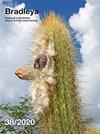Flower visitors and efficient pollinators of Opuntia joconostle F.A.C.Weber. ex Diguet in Jalisco, Mexico
IF 1.2
4区 生物学
Q3 PLANT SCIENCES
引用次数: 0
Abstract
Summary: The animals that visit the flowers, pollinators and reproductive system of Opuntia joconostle were studied. The objectives of the work were to identify its floral visitors, to determine which are the most effective pollinators and to evaluate the importance of floral visitors in seed production. To determine the richness and frequency of the animal visitors, five study visits were made from May to June 2017, during which the animals that interacted with the flowers were recorded and collected for a period of thirty minutes for each hour between 10am and 16pm, after which the pollen grains were removed from the body of the collected specimens. For pollination efficiency, the pollen deposited by a specific pollinator in a single visit on the stigma and by self-pollination was counted and seed production from flowers where pollinator visits were avoided and another group with no restrictions were compared. A total of 2,261 floral visitors were recorded, belonging to four orders, eleven families, and twenty-seven species. Bees were the most abundant floral visitors with 98% of the records; the species with the highest number of visits was Apis mellifera with 90%, followed by Diadasia australis with 5%. A higher number of pollen grains per insect were recorded in D. australis than in A. mellifera, D. australis deposited more pollen per visit than A. mellifera and by self-pollination. Flowers that received pollinators produced significantly more seeds per fruit than flowers where visitors were prevented. O. joconostle flowers are used by many animals, however, the majority are bees, particularly two species: A. mellifera and D. australis, the former having a higher frequency of visitation. However, D. australis carries and deposits more pollen. Joconostle seems to have a mixed autogamy/ xenogamy crossing system, as self-pollination was recorded, although it negatively affected seed production. Thus, cross-pollination is important for the conservation of this species, increasing its chances of reproductive success by seed and preserving genetic diversity.墨西哥哈利斯科前迪盖仙人掌的访花者和高效授粉者
综述:对仙人掌的访花动物、传粉昆虫和生殖系统进行了研究。这项工作的目的是确定其花卉访客,确定哪些是最有效的传粉者,并评估花卉访客在种子生产中的重要性。为了确定动物访客的丰富性和频率,2017年5月至6月进行了五次研究访问,在此期间,在上午10点至下午16点之间,每小时对与花朵互动的动物进行30分钟的记录和收集,然后从收集的标本身上去除花粉粒。为了提高授粉效率,对特定传粉者在柱头上单次授粉和自授粉时沉积的花粉进行了计数,并对避免传粉者授粉的花朵和另一组没有限制的花朵的种子产量进行了比较。共记录了2261名访花者,隶属于4目11科27种。蜜蜂是最丰富的花卉游客,有98%的记录;访问次数最多的物种是Apis mellifera(90%),其次是Diadasia australis(5%)。记录到的每只昆虫的花粉粒数在D.australis中比在A.mellifera中更高,D.australias每次访问和通过自授粉沉积的花粉比在A.mellifera中更多。接受传粉者授粉的花朵每果产生的种子明显多于阻止访客进入的花朵。许多动物都会使用O.joconostle花,然而,大多数是蜜蜂,尤其是两个物种:A.mellifera和D.australis,前者的造访频率更高。然而,D.australis携带并沉积了更多的花粉。Joconostle似乎有一个混合的自花授粉/异花授粉杂交系统,尽管它对种子生产产生了负面影响。因此,异花授粉对保护该物种、增加其通过种子繁殖成功的机会和保持遗传多样性很重要。
本文章由计算机程序翻译,如有差异,请以英文原文为准。
求助全文
约1分钟内获得全文
求助全文
来源期刊

Bradleya
PLANT SCIENCES-
CiteScore
2.80
自引率
25.00%
发文量
43
审稿时长
>12 weeks
期刊介绍:
Bradleya is the BCSS contribution to the scientific world and is accepted as such because of its academic standards. It can only flourish with the support of BCSS members, many of whom subscribe to it each year. The aim is to include articles which our members will find interesting and educational, whilst retaining rigorous standards of publication. Scientifically important articles don''t have to be dull to read. So, because Bradleya depends the subscriber, the editor endeavours to make its contents accessible, easily understood and enjoyable for all.
 求助内容:
求助内容: 应助结果提醒方式:
应助结果提醒方式:


